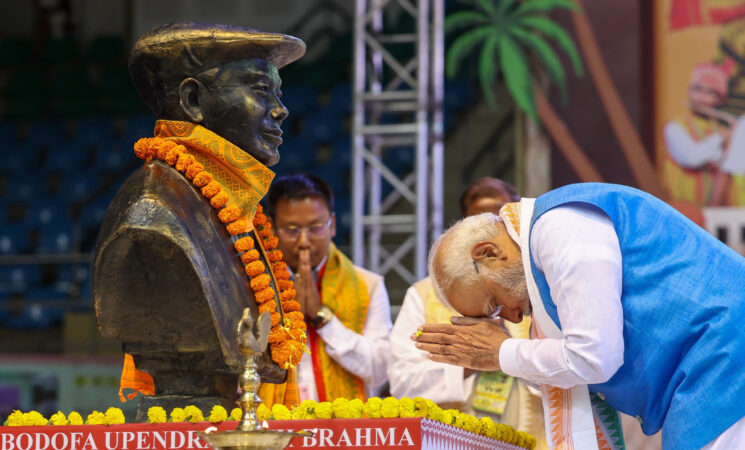23 March 2025, NIICE Commentary 10018
Agnes
Conflicts in South Asia stem mainly from historical legacies, disruptive nation-building processes, unequal development, and the marginalization of minorities. The politicization of ethnicity generates conflicts in South Asia, affecting regional cooperation and holding the region back economically and socially. The conflict in the Bodoland Territorial Region (BTR), situated in the northwestern part of Assam, India, emerged similarly.
With a distinct ethnic identity, it was always a struggle for the Bodos to get assimilated into the vibrant Assamese society. The discriminatory anti-tribal and chauvinist policies and attitudes towards the Bodos also made them keep fighting. Following a long period of ignorance, economic and political deprivation, and continuous oppression by other advanced communities, the Bodos initiated a movement demanding a separate state, seeking an equitable social order for themselves, free from exploitation and injustice.
Immigrants who inhabited the Bodo-dominated areas also created resentment and political consciousness among the Bodos. The flow of increasing immigrants created land problems, particularly for the Bodo population. These massive immigrants had shaken the fabric of the tribal economy, culture, and society. The movement witnessed participation from ABSU(All Bodo Students Union), AASU(All Assam Students Union), and other groups which constantly raised criticisms of the government and pushed for their political demands, including the demand for a separate state. Following the failures of the Bodoland Autonomous Council (BAC) due to the lack of constitutional protection and limited powers, the Bodoland Territorial Council(BTC) was formed in 2003, and it was granted more autonomy.
Ethnic militancy was an induced force of the movement, which was initially peaceful. Some violent instances of the movement can be traced back to 2nd October 2008, when communal violence broke out between Bodos and Muslims in Udalguri and Darrang districts. Over 55 people were killed and approximately 20,000 people were displaced. Minority villages were badly affected, leading to poor situations as the relief camps were opened and the relief measures became inadequate. On December 23, 2014, armed militants from the National Democratic Front of Bodoland (Songbijit faction, NDFB-S) attacked Adivasi villages in Sonitpur and Kokrajhar districts, killing at least 81 people, including women and children, which made the Asian Centre for Human Rights comment that India is no less vulnerable than Pakistan and the violence as crimes against humanity. The final Bodo accord, signed on January 27, 2020, after multiple rounds of negotiations between the Government of India, the Government of Assam, and Bodo revolutionary groups, was a milestone towards bringing lasting peace. The continuous pressure on the government and the recurrence of conflict costing lives, in fact, moved the region to a stable situation as peace became essential for trade, sustained economic growth, and prosperity. The Bodoland movement has many stories of suffering but has brought many positive impacts on the Bodo society, like the preservation of language, political consciousness, ethnic identity and culture, and social and economic development.
Post-2020 peace and development initiatives have created a conducive environment for investments in the Bodoland region. Those who took arms once have become protectors and caretakers of Bodoland’s forests. Bodoland aims at enhancing rail connectivity between Guwahati and Bhutan, passing through the Bodoland region, which will bolster bilateral relations and help in fostering regional tourism. BTC is also working on a cross-border tourism circuit that will connect Bhutan, Sikkim, and other northeastern states. There is a renewed focus on women and youth empowerment and livelihood improvement, including BTC’s Sericulture mission, which has increased the contribution, and the Bodoland region now contributes 30% of Assam’s Eri silk and 20% of India’s total production. Issuance of GI tag to recognize Bodoland’s unique heritage and traditions, including Bodo Dokhona and Bodo Eri silk also upholds its economic and cultural significance. Recently, the celebration of the First Bodoland Mahotsav in New Delhi marked a stride in acknowledging the region as an integral part of India, further fostering the idea of national integration and unity and that every region and every identity finds a place in the national discourse. The Mahotsav symbolized the resilience of the people of Bodoland and their aspiration to contribute to India’s growth story.
These developments can also be seen as part of the initiatives of the Indian Government to step up its engagement in India’s North East. Bodoland is rich in mineral reserves like limestone, quartz, and silica sand, but large-scale mining and industrial exploitation remain limited. With proper investments and sustainable practices, their development can contribute to the emergence of Assam as a significant hub in India’s semiconductor sector. Bodoland possesses huge ecological wealth, and its proximity to national parks and wildlife sanctuaries exhibits its immense potential for eco-tourism. While these moves are significant, the region isn’t devoid of hurdles. Lack of infrastructure and job scarcity forces the youth to migrate. There are demands for greater representation of Bodoland’s youth in paramilitary forces as the recruitment numbers remain insufficient and people seek continuous engagement from the Bodoland community, like the way it existed during the agitation.
At a time of heightened tensions and ethnic conflict in its neighborhood and as the waves of conflict rage across the world, the Bodo peace process stands testimony to the resolution of conflicts through dialogue, mutual respect, and a commitment to democratic principles.
Agnes is a Research Intern at NIICE & she has completed her Master's in Diplomacy, Law, and Business from the Jindal School of International Affairs(JSIA), O.P. Jindal Global University, India.

